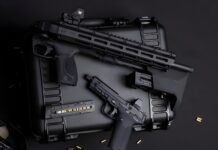
First seen on TTAG,
The letter (at the link above) is a draft that is allegedly about to be submitted into the ‘Request for Comment’ phase of ATF rule making, where a proposed rule change is open to the publics comments via email, fax, and letter to the ATF. The ATF are required by their rule making process to address and respond to all public comments prior to issuing a final rule, which in today’s climate could make for a long process.
It is that long process, despite the aggravation it has led to for manufacturers and owners, that it is theorized the ATF has been actively seeking to avoid. Keeping their determinations and rule making shrouded and nebulous saved them from the aggravation of this process but left us, the public, out in the cold, scratching our heads as to what was and was not an SBR vs a Braced Pistol/Firearm. What was Title I and what was Title II?
The ATF appears to be making that criteria public (finally) and objective so everyone understands. They are also looking at opening the NFA register up to tax free braced firearms, listing as corresponding SBR’s and SBS’s. So if you didn’t want to pay the tax and wait a ridiculous amount of time, now might be the time.
This is not yet a published, in the official sense, document so public comment is not open yet.
When it is, we will let you know. The portal for making comments http://www.regulations.gov/ will need to reference ATF 2020R-10 in the comment to be properly attributed. Follow the rules for commenting. They may also be mailed or faxed.
“Objective” Criteria
Objective: (of a person or their judgment) not influenced by personal feelings or opinions in considering and representing facts.
Now with that defined, scroll down to Background on the document. After establishing that it is the United States Attorney General’s responsibility to enforce the sometimes conflicting National Firearms Act and Gun Control Act (they state differing definitions), it outlines that the responsibility has been delegated to the BATFE, commonly ATF, and that the FATD within the ATF makes determinations on particular firearms to allow industry members “to plan, develop, and distribute products in compliance with the law,”
Then in the next paragraph they reverse course with, “Generally, when FATD evaluates a firearm sample, it examines configuration, physical characteristics, objective design features that are relevant under the statutory definitions of the GCA and NFA, and any other information that directly affects the classification of a particular firearm sample.”
Ok, all well and good so far although we are using “objective” still in a rather vague manner… Also the fact that definitions from 1934 and 1968 might not remain all encompassing doesn’t fill me with confidence about the ATF’s ability to make good and effective policy without the authority to update definitions in some manner based on public commentary and evidentiary rationale.
But…
“Even though firearms appear to have similar features, an ATF classification pertains only to the particular sample submitted, because variations in submissions, applicable statutes, judicial interpretations of these statutes, the manufacturer’s or maker’s intent, and the objective design features supporting that intent, make the general application of any particular classification exceedingly rare.”
So.. not that useful “to plan, develop, and distribute products in compliance with the law,” after all… huh. So why did the ATF bother with ‘Determination Letters’ at all? Why did we have the ‘It’s a Brace and Braces are cool.. unless you use it like a stock, which it isn’t, then that’s not cool.. but there is no illegal way to fire a pistol with all legal components installed and a brace is a legal component like we determined so, it is cool.. but don’t intend to use a Brace as a stock..’
What say you, ATF?
“ATF’s longstanding and publicly known positions…” I would argue ‘publicly known’ is a stretch because we keep asking and getting differing and inconsistent.. one might even say subjective instead of objective answers, but go on. “…is that a firearm does not evade classifications under the NFA merely because the firearm is configured with a device marketed as a “stabilizing brace” or “arm brace.” When an accessory and a weapon’s objective design features, taken together, are not consistent with use of the accessory as an arm brace, that is, not to stabilize a handgun when being operated with one hand, such weapon, configured with the accessory may fall within the scope of the NFA, particularly where the accessory functions as a shoulder stock for the weapon. Accordingly, ATF must evaluate whether a particular firearm configured with a stabilizing brace bears objective features of a firearm designed and intended to be fired from the shoulder, and thus subject to the NFA, on a case-by-case basis.”
One problem with all that, what are the, “objective features of a firearm designed and intended to be fired from the shoulder” other than a buttstock aka ‘shoulder stock’? Seems fairly interpretive and not objective.
‘Speed Limit 70 MPH’ is objective, it is defined, we know what 70 MPH is. “Too fast for conditions” can also be objective based upon known factors like icing, vehicle performance, and observed control. But there is an environmental factor at work in that case that may or may not present a danger and ATF is essentially trying to use similar logic.
The problem is there isn’t a consistent ‘environmental’ factor. It isn’t illegal to fire a pistol from the shoulder, it is impractical to do so for conventional handgun designs, but not illegal and it doesn’t reclassify the gun. It is also less practical or impractical to fire from the hip, or one handed instead of two handed, but not illegal. So those environmental factors of use and intent are always going to be subjectively applied. Most attempts at making an objective (meaning written based on numerical and physical standards that can be objectively measured and followed) would become immediately discriminatory or arbitrarily picked. Pistols over 80oz for example, as a measure of what is too heavy to shoot one handed (ironically, why the pistol brace exists) even when objectively speaking two handed is safer and superior.
The braces exist because of somewhat ridiculous but objective definitions. Look at what the ATF states has been “designed or redesigned, made or remade, and intended to be fired from the shoulder.” (Page 7 & 8)
They then go further and state, “No single factor or combination of factors is dispositive, and FATD examines each weapon holistically on a case-by-case basis.” Meaning, to objectively say whether or not it is a pistol or SBR/SBS/Firearm, the ATF would have to see every single firearm individually and the determination would only cover firearms made exactly to the standard of one examined.
This task and burden is objectively absurd. Especially when considering the NFA is “to regulate certain weapons likely to be used for criminal purposes,” and we can objectively prove that the two greatest factors determinate of criminal misuse are total cost of acquisition (both risk based and financial) and concealability.
It comes down to this. For every factor the ATF is trying to use to be objective, there is another they are generally ignoring for one reason or another that makes such a factor subjective. The environmental factors, as I termed it earlier, are too wide ranging, ill defined, and inconsistently applied for the ATF to issue a detailed ruling.
Solution
Objectively, SBRs, SBSs, and Suppressors/Silencers should not be NFA items. They should fall under Title I. A case could still be made that select fire weapons (machine guns) and destructive devices should remain NFA, as they differ enough from Title I firearms to a degree that a different classification becomes relevant. There is no effective evidentiary basis for saying an AR-15 with a 15.9″ barrel is more dangerous, and therefore rationally subject to additional regulation, than one with a 16.1″ barrel. The 14.5″ M4 Clones and the 20″ M16 Clones, and every AR variation on those themes of any length with stock or brace or bare tube, rationally represent approximately the same threat to law enforcement and the general public. The existence of the AR-Type Pistol and Pistol Brace serve to emphasize that point.
The solution, the objective solution, is to expand and simplify the Title I definition to encompass all manual loading and semi-automatic firearms.
I will be commenting such when comments open. You should too.



